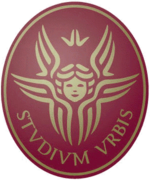
Back Universiteit van Rome Afrikaans جامعة روما سابينزا Arabic جامعة روما ساپيينزا ARZ Universidá de Roma La Sapienza AST Roma Sapientsa Universiteti Azerbaijani ساپینزا رم بیلیمیوردو AZB Сапиенца (университет) Bashkir Рымскі ўніверсітэт «Ла Сапіенца» Byelorussian Рымскі ўнівэрсытэт Ля-Сапіенца BE-X-OLD Римски университет „Сапиенца“ Bulgarian
Sapienza – Università di Roma (Italian) | |
 | |
| Latin: Studium Urbis[1][2] | |
| Motto | Il futuro è passato qui |
|---|---|
Motto in English | The future has passed through here |
| Type | Public |
| Established | 1303 |
| Rector | Antonella Polimeni |
Administrative staff | 8,000 |
| Students | 112,564[3] |
| Undergraduates | 63,957[4] |
| Postgraduates | 26,212[4] |
| 18,793[4] | |
| Location | , Italy |
| Campus | Urban, Urban |
| Colors | Pompeian red & gold[5][6] |
Sporting affiliations | CUS Roma |
| Website | www |
 | |
The Sapienza University of Rome[7] (Italian: Sapienza – Università di Roma), formally the Università degli Studi di Roma "La Sapienza", abbreviated simply as Sapienza ("wisdom"), is a public research university located in Rome, Italy.[8] It was founded in 1303 and is as such one of the world's oldest universities,[9] and with 122,000 students, it is the largest university in Europe.[10] Due to its size, funding, and numerous laboratories and libraries, Sapienza is a global major education and research centre, first ranked in Southern Europe.[11][12] The university is located mainly in the Città Universitaria (University city), which covers 44 ha (110 acres) near the monumental cemetery Campo Verano, with different campuses, libraries and laboratories in various locations in Rome.
Sapienza was founded on 20 April 1303 by decree from Pope Boniface VIII as a Studium for ecclesiastical studies under more control than the free-standing universities of Bologna and Padua. In 1431 Pope Eugene IV completely reorganized the studium and decreed that the university should expand to include the four schools of Law, Medicine, Philosophy, in addition to the existing Theology. In the 1650s the university became known as Sapienza, meaning "wisdom", a title it still retains.[13] After the capture of Rome by the forces of the Kingdom of Italy in 1870, La Sapienza rapidly expanded as the chosen main university of the capital of the newly unified state. In 1935 the new university campus, planned by Marcello Piacentini, was completed.[14]
Sapienza teaches and conducts research in all pure and applied sciences and humanities. It is often considered the best in the world for classics and ancient history.[15][16] Sapienza houses 50 libraries with over 2.7 million books, most notably the Alessandrina University Library, built in 1667 by Pope Alexander VII, housing 1.5 million volumes.[17] In addition it has 19 museums, a botanical garden, and three university hospitals.[18] Sapienzas alumni includes 10 Nobel laureates, Italian prime ministers, one pope, Presidents of the European Parliament and European Commissioners, as well as several notable religious figures, supreme court judges, and astronauts.[19]
- ^ "Il nome Sapienza" [The name Sapienza]. uniroma1.it (in Italian). Retrieved 13 November 2024.
- ^ "Search". Internet Archive.
- ^ "Anagrafe Nazionale Studenti". miur.it.
- ^ a b c "Sapienza at a Glance. Facts and figures 2023-2024" (PDF). Sapienza - Università di Roma.
- ^ "Sapienza University of Rome – Identity Guidelines". Archived from the original on 25 August 2012.
- ^ "Sapienza University of Rome - Graphic manual" (PDF). June 2007. Retrieved 7 August 2020.
- ^ "Foundation Year at Sapienza University of Rome". Sapienza - Università di Roma.
- ^ Official Sapienza University of Rome name and logos writing guidelines Archived 17 January 2009 at the Wayback Machine
- ^ "La Storia".
- ^ "Chi Siamo".
- ^ "Università, ecco le migliori del mondo: La prima italiana è la Sapienza (163° posto)". 15 August 2016.
- ^ "Chi siamo – Sapienza – Università di Roma". uniroma1.it.
- ^ "ANNA FOA, Ateismo e magia. Il declino della concezione magica nel Dictionnaire di Pierre Bayle, Roma, Edizioni dell'Ateneo, 1980. Istituto di Storia Moderna, Facolt di Lettere e Filosofia, Universit di Roma". Annali dell'Istituto e Museo di Storia della Scienza di Firenze. 6 (2): 161–162. 1981. doi:10.1163/221058781x00538. ISSN 0391-3341.
- ^ "University of Rome | Ancient, Papal, Catholic | Britannica". www.britannica.com. Retrieved 9 April 2024.
- ^ Rome, Wanted in (4 March 2021). "Rome's La Sapienza rated top university in the world for Classics". Wanted in Rome. Retrieved 9 April 2024.
- ^ Will Martin. "QS ranking of global universities by excellence in subjects - Business Insider". Businessinsider.fr. Retrieved 18 October 2019.
- ^ "Direzione generale Biblioteche e diritto d'autore Biblioteca Universitaria Alessandrina". biblioteche.cultura.gov.it. Retrieved 9 April 2024.
- ^ "Sapienza" (PDF). UniRoma. 2014. Retrieved 11 July 2014.
- ^ "Università "La Sapienza":sfide, titoli e speranze". Corriere della Sera (in Italian). 13 September 2015. Retrieved 9 April 2024.